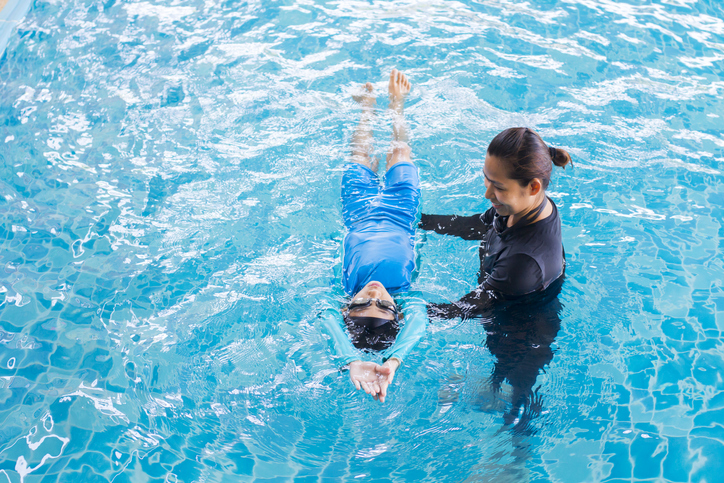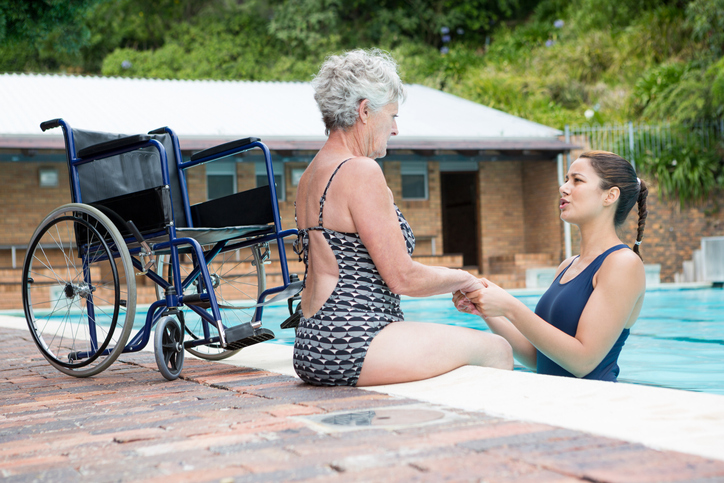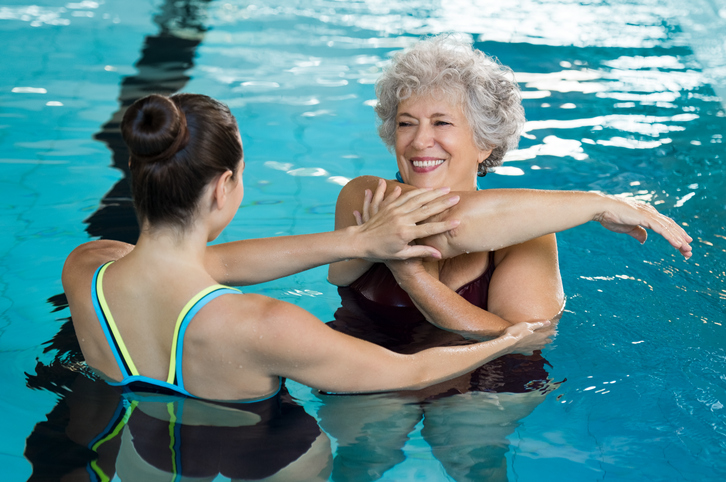Aqua-phobia, real and terrifying. As a 20-year veteran of swim instruction, I have seen a lot of fear of drowning phobias in children and adults. I've taken courses in psychology and trained with master instructors on how to help clients overcome their fears of the water. I have discovered that you need two basic skill sets as an instructor when working with fearful adults: Listening and Patience.
Find the root of the fear
Those living with fear and anxiety, have a story to tell, and they need to be heard, really heard. Those living with fear and anxiety, need to be reminded that they are safe, so we teach them, slowly. Those living with fear and anxiety need to be reminded that we are not going to rush them, we humbly and patiently wait for when they are ready to take the "next step".
Just as we would never put a child directly into the deep end, nor would we put a fearful adult. I feel there are two types of adults that attend swim lessons; those who never learned how to swim; and those who did learn but suffered a traumatic aquatic incident. Therefore, listening to a person’s story is key to taking the next steps.
No fear, no problem
If an adult student has not ever learned how to swim, and has not suffered a traumatic incident, I take the same approach as I do with any other student: Bubbles and Breath-work, Full Body Submersion, and Flotation. After these basic skills are mastered, most adults move quickly into learning to swim without fear.
What’s “personal depth fear”?
When anyone has lived through a traumatic aquatic experience, you must determine their personal “depth” fear. By this, I mean how deep in the water are they willing to go. Some adults will not put a literal toe in open water, and some might be willing to go as far as neck deep.
If a person is not willing to enter the water, a good place to start is walking the border of the pool while explaining the scientific properties of water, i.e. buoyancy, drag, etc. Adults have the competency to understand and absorb the knowledge of the water, and knowledge is power. This is a great way to help your client feel more at ease. Another non-entry activity is using a giant bowl of water to practice blowing bubbles and breathe holding can be done.
Just breathe and discover
If entry into the water is being done at a very slow pace, sitting on the edge of the pool with the feet in, while practicing breathing diaphragmatic breath-work, can also be very healing! Once able to take your client waste deep, you can guide them through fun balancing techniques like Ai Chi, Aqua Yoga, dancing, etc. This will help your students feel more stable and confident in the water.
Monkey around
Another fun and empowering technique is the ‘wall crawl’ around the inside of the pool. This is great for overcoming hydrophobia and fears of the deep end. When my students have mastered monkey crawling to the deep, I like to have them spend time there, at first without head or face submersion while still holding on, and later moving into face submersion with goggles. I have found this very helpful, as seeing the bottom of the pool become less scary over time.
Going under water, submersion time!
When it comes time to work on submersion skills, literal hand holding is very important if your student suffers from severe anxiety. First time submersion can trigger panic attacks and cause hyperventilation and loss of balance, even in very shallow water and even if they have already mastered breath-work. First time full body submersion should be done facing your client, holding hands, wide legged squatting to standing in the shallow end of the pool, while focusing on proper inhalation and exhalation. When hand holding is no longer required, but fear is still present, I will give my student a noodle or flotation device that they can hold while independently practicing their submersion squats. Once full body submersion can be completed at a slow pace, with good breath-work, you can have more fun with your client and amp up the pace. Bobs and jumps are fun and empowering as well!
I find that submersion is the first most challenging part of teaching fearful adult swimmers with water phobia to overcome a fear of swimming. The second is floating. For most adults with a fear of swimming it’s not about the ability to float, its about the trust in us, the instructor. It is important to constantly reaffirm to your student that you will not “let them go under”. Gaining the trust of your student is about how well you listen and respond to their feelings, and your never wavering patience.
As a WATSU practitioner, I am used to having body to body contact in the water. This may be a challenge for some instructors. Some of the basic ways we teach others to float, simply don’t work with fearful adults as they need more physical support. I have found it necessary when I teach floating skills, with some clients I will have them positioned with their head on my shoulder, in a floating position, so I can use my hands and even feet to guide them to float upward. I find the more nurturing we are with fearful adults, the quicker the overcoming of their fears can be.
Everyone has their own pace, be patient
After deep breathing, submersion, and floating are mastered, your client should be ready to easily progress into the next level of movement through the water. If not, readdress the client’s intense fears, and remind them that with these three key skills they are ready to be a strong and safe swimmer!!
Ready to overcome your fear of water and open up a whole new way to exercise and begin to enjoy water based activities? Get started with a professional swim instructor in your area who is experienced teaching fearful adults.
Erin Moynihan’s bio:
Swim Instructor in Tarpon Springs, FL
Erin Moynihan is certified in Aquatic Therapy, WATSU, 200HR Yoga Therapy, Wellness Coaching, AEA, and Angelfish Special needs. I have been teaching swim lessons for over 10 years. I am also certified as an aquatics therapist and yoga therapist. I have extensive knowledge and experience working with special needs children/adults/and seniors. I believe that swimming is a necessary life skill, that all people should have an opportunity to learn and enjoy!
ABOUT SUNSATIONAL SWIM SCHOOL
Sunsational Swim School is the 🥇 #1 rated provider of private, at-home swimming lessons in America. We have specialized swim instructors for students ages 6 months to adult, beginner to advanced. Featured on ABC, CBS, Impact 100, The List and others, Sunsational instructors have a minimum of 2 years of teaching experience, are CPR certified and insured, and have collectively taught over 302,223 lessons for more than 74,415 students nationwide!





